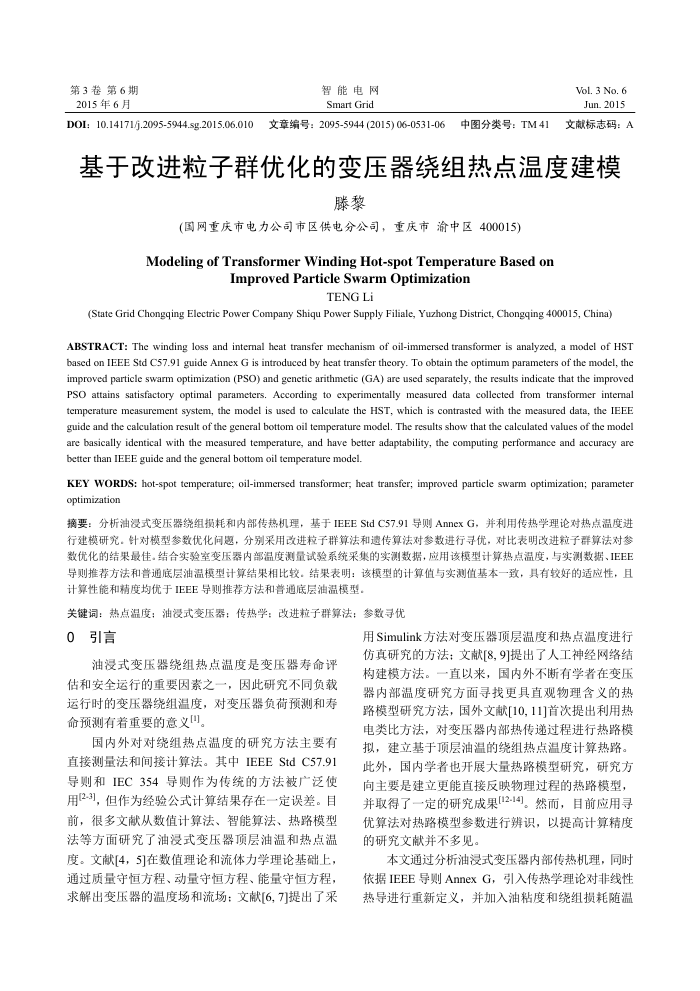基于改进粒子群优化的变压器绕组热点温度建模
内容简介
 第3卷第6期 2015年6月
第3卷第6期 2015年6月DOI: 10.14171/j.2095-5944.sg.2015.06.010
智能电网 Smart Grid
文章编号:2095-5944 (2015)06-0531-06
中图分类号:TM41
Vol. 3 No. 6 Jun.2015 文献标志码:A
基于改进粒子群优化的变压器绕组热点温度建模
滕黎
(国网重庆市电力公司市区供电分公司,重庆市渝中区400015)
ModelingofTransformerWindingHot-spotTemperatureBasedon
ImprovedParticleSwarmOptimization
TENGLi
(State Grid Chongqing Electric Power Company Shiqu Power Supply Filiale, Yuzhong District, Chongqing 400015, China)
ABSTRACT: The winding loss and intemal heat transfer mechanism of oil-immersed transformer is analyzed, a model of HST based on IEEE Std C57.91 guide Annex G is introduced by heat transfer theory. To obtain the optimum parameters of the model, the improved particle swarm optimization (PSO) and genetic arithmetic (GA) are used separately, the results indicate that the improved PSO attains satisfactory optimal parameters. According to experimentally measured data collected from transformer intermal temperature measurement system, the model is used to calculate the HST, which is contrasted with the measured data, the IEEE guide and the calculation result of the general bottom oil temperature model. The results show that the calculated values of the model are basically identical with the measured temperature, and have better adaptability, the computing performance and accuracy arc better than IEEE guide and the general bottom oil temperature model.
KEY WORDS: hot-spot temperature; oil-immersed transformer, heat transfer; improved particle swarm optimization; parameter optimization
摘要:分析油式变压器绕组损耗和内部传热机理,基于IEEEStdC57.91导则AnnexG,并利用传热学理论对热点温度进行建模研究。针对模型参数优化间题,分别采用改进粒子群算法和遗传算法对参数进行寻优,对比表明改进粒子群算法对参数优化的结果最佳。结合实验室变压器内部温度测量试验系统采集的实测数据,应用该模型计算热点温度,与实测数据、正EEE 导则推荐方法和普通底层油温模型计算结果相比较。结果表明:该模型的计算值与实测值基本一致,具有较好的适应性,且计算性能和精度均优于IEEE导则推荐方法和普通底层油温模型。
关键词:热点温度:油没式变压器:传热学:改进粒子群算法:参数导优
0引言
油浸式变压器绕组热点温度是变压器寿命评估和安全运行的重要因素之一,因此研究不同负载运行时的变压器绕组温度,对变压器负荷预测和寿命预测有着重要的意义。
国内外对对绕组热点温度的研究方法主要有直接测量法和间接计算法。其中IEEEStdC57.91 导则和IEC354导则作为传统的方法被广泛使用[2-3],但作为经验公式计算结果存在一定误差。目前,很多文献从数值计算法、智能算法、热路模型法等方面研究了油浸式变压器顶层油温和热点温度。文献[4,5]在数值理论和流体力学理论基础上,通过质量守恒方程、动量守恒方程、能量守恒方程,求解出变压器的温度场和流场:文献[6,7]提出了采
用Simulink方法对变压器顶层温度和热点温度进行仿真研究的方法;文献[8,9]提出了人工神经网络结构建模方法。一直以来,国内外不断有学者在变压器内部温度研究方面寻找更具直观物理含义的热路模型研究方法,国外文献[10,11]首次提出利用热电类比方法,对变压器内部热传递过程进行热路模拟,建立基于项层油温的绕组热点温度计算热路。此外,国内学者也开展大量热路模型研究,研究方向主要是建立更能直接反映物理过程的热路模型并取得了一定的研究成果[12-14]。然而,目前应用寻优算法对热路模型参数进行辨识,以提高计算精度的研究文献并不多见。
本文通过分析油浸式变压器内部传热机理,同时
依据IEEE导则AnnexG,引入传热学理论对非线性热导进行重新定义,并加入油粘度和绕组损耗随温
上一章:智能电力变压器整体联调检测方法研究
下一章:变压器油在线监测装置输油管漏油分析